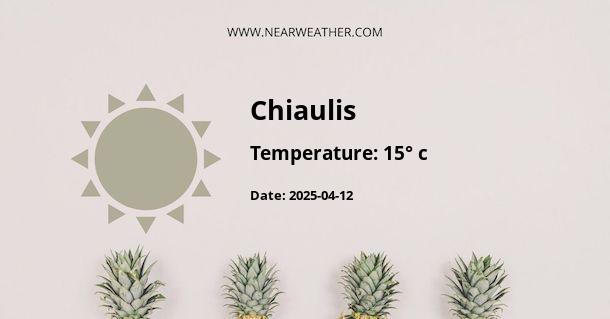The Unique Climate and Weather of Chiais, Italy
Chiaulis, Italy, nestled within the beautiful Friuli-Venezia Giulia region, offers a distinct climate influenced by both the Adriatic Sea and the majestic Alps. This serene Italian location presents a diverse meteorological tapestry that weaves together Mediterranean and continental climate characteristics. In this comprehensive exploration, we will delve into the climatic features of Chiaulis, examining its weather patterns throughout the seasons.
Geographical Influence on Weather
The geographical location of Chiaulis plays a significant role in its weather manifestations. Closely located to both the Adriatic Sea and the Alpine mountain range, this area experiences an interplay between maritime and mountainous climate influences, resulting in weather patterns that capture the essence of both environments.
Temperature Patterns in Chiaulis
Temperature in Chiaulis exhibits a classical seasonal pattern with mild to warm summers and cool to cold winters. The temperature ranges can be broken down as follows:
- Spring: The transition from winter to summer begins in March, with temperatures gradually increasing from an average low of 5°C to a high of 15°C by May.
- Summer: From June to August, summer temperatures are comfortable, boasting averages from a low of 15°C to a high of 25°C, making it an ideal time for outdoor activities.
- Autumn: September ushers in cooler temperatures as the leaves change color, with the average lows of 10°C and highs around 20°C. By November, the autumn chill sets in, with temperatures dropping further.
- Winter: December marks the onset of winter, with average temperatures ranging from a low of -2°C to a high of 5°C. Influenced by the Alps, Chiaulis often receives snowfall during this season.
These temperature ranges are general and can fluctuate yearly. Global climate change also has potential impacts on these traditional patterns.
Precipitation Trends
The precipitation in Chiaulis varies throughout the year:
- Spring: Although spring brings increased temperatures, it also delivers rain showers. Precipitation during these months can assist in the bloom of local flora.
- Summer: Summers are relatively dry with occasional thunderstorms. These storms can bring heavy rainfall over short periods but are typically followed by clear skies.
- Autumn: The region witnesses a higher incidence of precipitation in the autumn months. This increased rainfall contributes to the region's lush landscapes.
- Winter: Winter months can bring mixed precipitation including snow, especially due to the proximity to the Alps. The precipitation levels in winter add to the charm of Chiaulis, turning it into a picturesque winter haven.
It's essential to consider the influence of local topography and larger climatic patterns such as the North Atlantic Oscillation (NAO) on the region's precipitation.
Wind and Humidity
Chiaulis encounters varying wind conditions that can influence local weather experiences:
- Bora Wind: This strong northeast wind can occur during any season but is most frequent and intense during winter. It can lower temperatures sharply and is a defining characteristic of the region's climate.
- Scirocco: This warm and humid southeast wind, originating from the Sahara Desert, can impact the region, particularly in spring and autumn, raising temperatures and sometimes carrying Sahara dust.
Humidity levels in Chiaulis can be high due to proximity to the sea, particularly during the summer and autumn months which can exacerbate the perceived temperatures.
Extreme Weather Events and Climate Change
While Chiaulis generally enjoys a temperate climate, it is not immune to extreme weather events. Heavy storms, flash floods, and heatwaves are instances of extreme patterns that can affect the region. The influence of climate change is increasingly evident with altered precipitation patterns and more frequent extreme weather events. It is imperative to stay informed about the latest climate research to understand these shifts in depth.
Weather-Year Round: A Monthly Overview
January: Cold with potential snow. Averages: 0°C - 7°C
February: Still chilly, snow possible. Averages: 1°C - 8°C
March: Beginning of spring, milder. Averages: 5°C - 15°C
April: Mild with increasing rainfall. Averages: 8°C - 18°C
May: Warmer, end of spring. Averages: 13°C - 23°C
June: Start of summer, pleasant. Averages: 16°C - 25°C
July: Warmest month. Averages: 18°C - 28°C
August: Hot, peak of summer. Averages: 17°C - 27°C
September: Transition to autumn, cooler. Averages: 14°C - 24°C
October: Crisp, cooler temperatures. Averages: 10°C - 19°C
November: Noticeably colder, wetter. Averages: 5°C - 12°C
December: Winter sets in, cold. Averages: 1°C - 7°C
Planning Your Visit
Depending on the experience one is seeking, the best time to visit Chiaulis varies. For those seeking mild weather and blossoming nature, spring and early summer are ideal. For winter sports enthusiasts, the cold months are more suitable. When planning a trip to Chiaulis, it's critical to consider both the typical climatic conditions and the local events that may be affected by the weather.
Conclusion
The weather and climate in Chiaulis, Italy, reflect a rich blend of Mediterranean and Alpine influences, offering a year-round exhibit of weather patterns in a splendid Italian setting. Understanding the dynamics of Chiaulis' climate not only assists in travel preparation but also contributes to a deeper appreciation of the region's natural beauty and climatic uniqueness.
A - Chiaulis's Latitude is 46.388771 & Longitude is 12.991550.
A - Weather in Chiaulis is 15° today.
A - Climate Conditions in Chiaulis shows overcast clouds today.
A - Humidity in Chiaulis is 78% today.
A - Wind speed in Chiaulis is 4.43 km/h, flowing at 177° wind direction. today.
